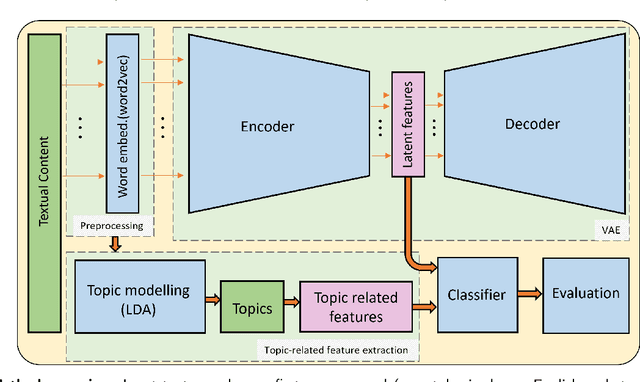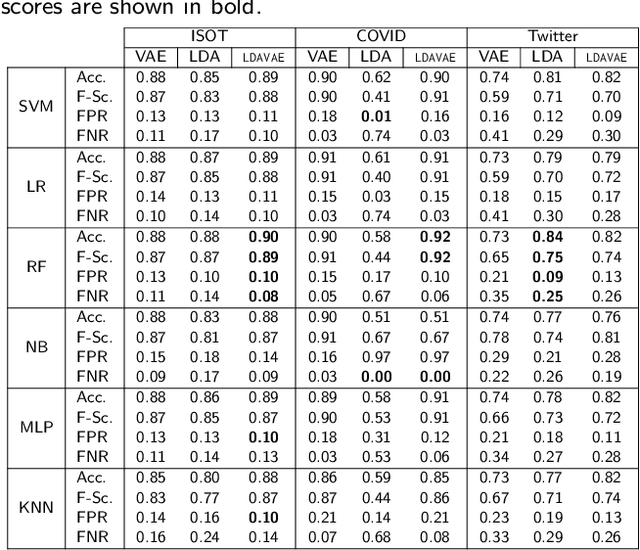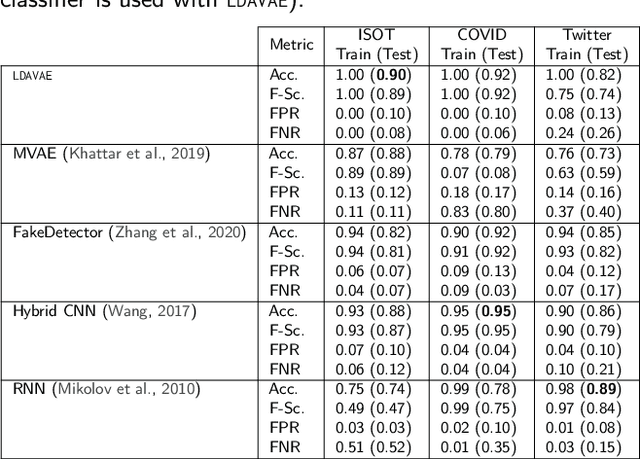Suining He
Interpretable Fake News Detection with Topic and Deep Variational Models
Sep 04, 2022



Abstract:The growing societal dependence on social media and user generated content for news and information has increased the influence of unreliable sources and fake content, which muddles public discourse and lessens trust in the media. Validating the credibility of such information is a difficult task that is susceptible to confirmation bias, leading to the development of algorithmic techniques to distinguish between fake and real news. However, most existing methods are challenging to interpret, making it difficult to establish trust in predictions, and make assumptions that are unrealistic in many real-world scenarios, e.g., the availability of audiovisual features or provenance. In this work, we focus on fake news detection of textual content using interpretable features and methods. In particular, we have developed a deep probabilistic model that integrates a dense representation of textual news using a variational autoencoder and bi-directional Long Short-Term Memory (LSTM) networks with semantic topic-related features inferred from a Bayesian admixture model. Extensive experimental studies with 3 real-world datasets demonstrate that our model achieves comparable performance to state-of-the-art competing models while facilitating model interpretability from the learned topics. Finally, we have conducted model ablation studies to justify the effectiveness and accuracy of integrating neural embeddings and topic features both quantitatively by evaluating performance and qualitatively through separability in lower dimensional embeddings.
Towards Spatio-Temporal Cross-Platform Graph Embedding Fusion for Urban Traffic Flow Prediction
Aug 21, 2022



Abstract:In this paper, we have proposed STC-GEF, a novel Spatio-Temporal Cross-platform Graph Embedding Fusion approach for the urban traffic flow prediction. We have designed a spatial embedding module based on graph convolutional networks (GCN) to extract the complex spatial features within traffic flow data. Furthermore, to capture the temporal dependencies between the traffic flow data from various time intervals, we have designed a temporal embedding module based on recurrent neural networks. Based on the observations that different transportation platforms trip data (e.g., taxis, Uber, and Lyft) can be correlated, we have designed an effective fusion mechanism that combines the trip data from different transportation platforms and further uses them for cross-platform traffic flow prediction (e.g., integrating taxis and ride-sharing platforms for taxi traffic flow prediction). We have conducted extensive real-world experimental studies based on real-world trip data of yellow taxis and ride-sharing (Lyft) from the New York City (NYC), and validated the accuracy and effectiveness of STC-GEF in fusing different transportation platform data and predicting traffic flows.
Towards Dynamic Urban Bike Usage Prediction for Station Network Reconfiguration
Aug 13, 2020



Abstract:Bike sharing has become one of the major choices of transportation for residents in metropolitan cities worldwide. A station-based bike sharing system is usually operated in the way that a user picks up a bike from one station, and drops it off at another. Bike stations are, however, not static, as the bike stations are often reconfigured to accommodate changing demands or city urbanization over time. One of the key operations is to evaluate candidate locations and install new stations to expand the bike sharing station network. Conventional practices have been studied to predict existing station usage, while evaluating new stations is highly challenging due to the lack of the historical bike usage. To fill this gap, in this work we propose a novel and efficient bike station-level prediction algorithm called AtCoR, which can predict the bike usage at both existing and new stations (candidate locations during reconfiguration). In order to address the lack of historical data issues, virtual historical usage of new stations is generated according to their correlations with the surrounding existing stations, for AtCoR model initialization. We have designed novel station-centered heatmaps which characterize for each target station centered at the heatmap the trend that riders travel between it and the station's neighboring regions, enabling the model to capture the learnable features of the bike station network. The captured features are further applied to the prediction of bike usage for new stations. Our extensive experiment study on more than 23 million trips from three major bike sharing systems in US, including New York City, Chicago and Los Angeles, shows that AtCoR outperforms baselines and state-of-art models in prediction of both existing and future stations.
 Add to Chrome
Add to Chrome Add to Firefox
Add to Firefox Add to Edge
Add to Edge